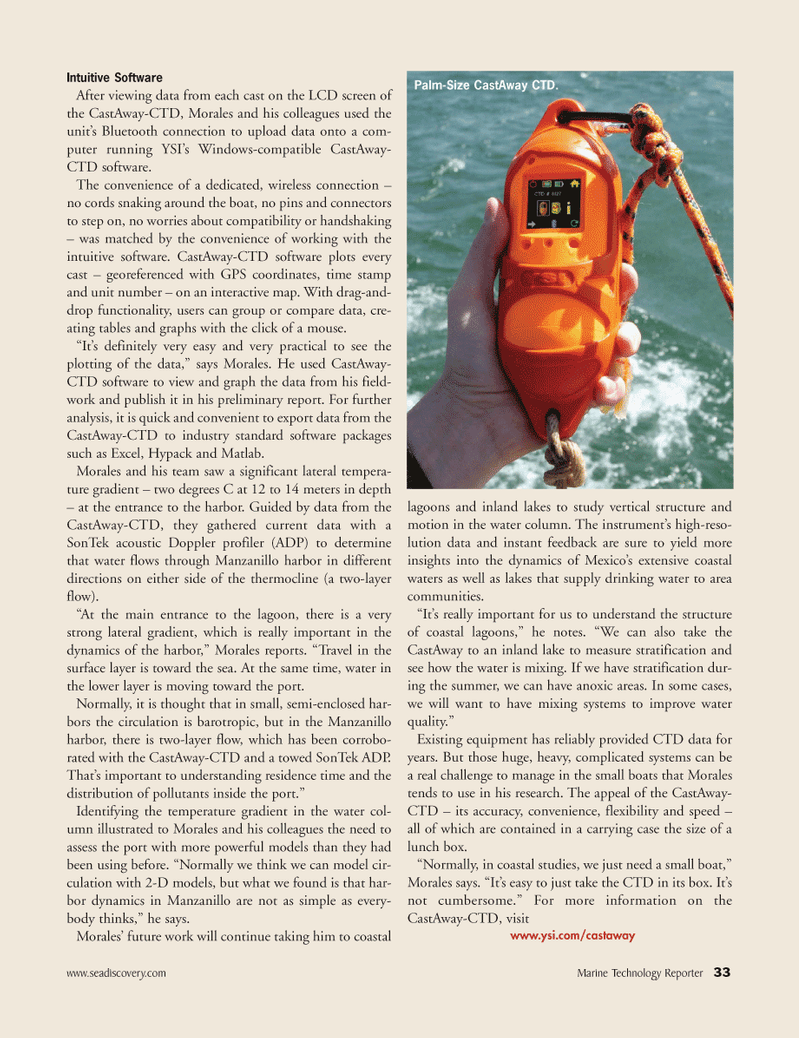
Page 33: of Marine Technology Magazine (October 2010)
Ocean Engineering & Design
Read this page in Pdf, Flash or Html5 edition of October 2010 Marine Technology Magazine
www.seadiscovery.com Marine Technology Reporter 33
Intuitive Software
After viewing data from each cast on the LCD screen of the CastAway-CTD, Morales and his colleagues used the unit’s Bluetooth connection to upload data onto a com- puter running YSI’s Windows-compatible CastAway-
CTD software.
The convenience of a dedicated, wireless connection – no cords snaking around the boat, no pins and connectors to step on, no worries about compatibility or handshaking – was matched by the convenience of working with the intuitive software. CastAway-CTD software plots every cast – georeferenced with GPS coordinates, time stamp and unit number – on an interactive map. With drag-and- drop functionality, users can group or compare data, cre- ating tables and graphs with the click of a mouse. “It’s definitely very easy and very practical to see the plotting of the data,” says Morales. He used CastAway-
CTD software to view and graph the data from his field- work and publish it in his preliminary report. For further analysis, it is quick and convenient to export data from the
CastAway-CTD to industry standard software packages such as Excel, Hypack and Matlab.
Morales and his team saw a significant lateral tempera- ture gradient – two degrees C at 12 to 14 meters in depth – at the entrance to the harbor. Guided by data from the
CastAway-CTD, they gathered current data with a
SonTek acoustic Doppler profiler (ADP) to determine that water flows through Manzanillo harbor in different directions on either side of the thermocline (a two-layer flow). “At the main entrance to the lagoon, there is a very strong lateral gradient, which is really important in the dynamics of the harbor,” Morales reports. “Travel in the surface layer is toward the sea. At the same time, water in the lower layer is moving toward the port.
Normally, it is thought that in small, semi-enclosed har- bors the circulation is barotropic, but in the Manzanillo harbor, there is two-layer flow, which has been corrobo- rated with the CastAway-CTD and a towed SonTek ADP.
That’s important to understanding residence time and the distribution of pollutants inside the port.”
Identifying the temperature gradient in the water col- umn illustrated to Morales and his colleagues the need to assess the port with more powerful models than they had been using before. “Normally we think we can model cir- culation with 2-D models, but what we found is that har- bor dynamics in Manzanillo are not as simple as every- body thinks,” he says.
Morales’ future work will continue taking him to coastal lagoons and inland lakes to study vertical structure and motion in the water column. The instrument’s high-reso- lution data and instant feedback are sure to yield more insights into the dynamics of Mexico’s extensive coastal waters as well as lakes that supply drinking water to area communities. “It’s really important for us to understand the structure of coastal lagoons,” he notes. “We can also take the
CastAway to an inland lake to measure stratification and see how the water is mixing. If we have stratification dur- ing the summer, we can have anoxic areas. In some cases, we will want to have mixing systems to improve water quality.”
Existing equipment has reliably provided CTD data for years. But those huge, heavy, complicated systems can be a real challenge to manage in the small boats that Morales tends to use in his research. The appeal of the CastAway-
CTD – its accuracy, convenience, flexibility and speed – all of which are contained in a carrying case the size of a lunch box. “Normally, in coastal studies, we just need a small boat,”
Morales says. “It’s easy to just take the CTD in its box. It’s not cumbersome.” For more information on the
CastAway-CTD, visit www.ysi.com/castaway
Palm-Size CastAway CTD.

 32
32

 34
34
